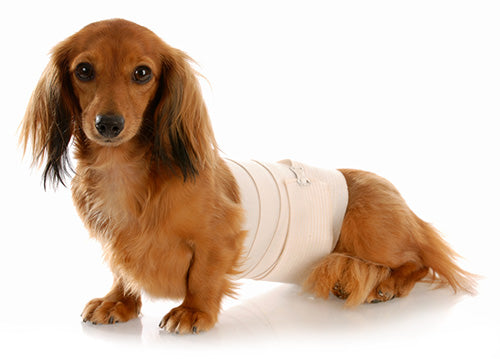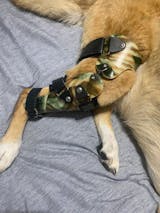|
Intervertebral Disc Disease, or IVDD, is a disease affecting the joints in the spine, often seen in small breeds of dog such as Dachshunds, Pekingese, Beagles, Corgi, Shih Tzu, Maltese, and other small breeds that tend to have longer bodies with short legs. IVDD is especially prevalent in Dachshunds; an estimated 1 in 5 dogs will suffer from this disease. IVDD is a very serious condition and results in intense pain and can even lead to paralysis.
The main problems IVDD causes are back pain, rear limb paralysis, and inability to walk or feel the back legs. This often includes incontinence for the dog and a less full quality of life.
|
 |
Let’s start by looking at how the vertebral column and spinal cord are built. The canine vertebral column, or backbone, is just like a person’s in that it is made up of a series of small bones, called the vertebrae. These bones surround and protect the spinal cord, a bundle of nerves. The nerves’ main job is to send communication between the body and the brain. To move and feel sensations normally, a dog needs a healthy spinal cord. This would include feelings like being touched, feeling pain, and feeling the sensation of needing to “do their doggie business” too.
Every single individual hard vertebrae bone is separated by soft intervertebral disks, which act like cushions or shock absorbers. Understanding these is the key to understanding IVDD. Built like a coconut, each disk starts with a fibrous outer layer with a jelly-like inside. That outer fibrous layer protects and contains the inner jelly-like portion to prevent it from bulging out.
What is IVDD?
In a nutshell, IVDD starts when the jelly-like inner layer starts hardening, so it can’t cushion like it’s supposed to. Then, that inner layer bulges out, or herniates, causing pressure on the dog’s spinal cord. It can bulge out a little or a lot. It can hit an important spot in the spine or a super important spot in the spine (there are no unimportant parts of a spine!). So, that’s why you’ll see some problems caused by IVDD as far more serious than others.
What problems can IVDD cause?
Back problems your dog may experience with a milder version of IVDD can include mild back or neck pain. With severe IVDD symptoms, your dog can experience loss of all sensation, lack of bladder and bowel control, and even paralysis.
Are these problems temporary or permanent?
As the disc bulges, it compresses the spinal cord. Small compression with a milder version can cause temporary pain which comes and goes. IVDD symptoms may be temporary if steps are taken to help the dog heal. For more severe IVDD, these problems can be permanent.

Dog Breeds Affected
Intervertebral Disk Disease, IVDD, is often seen in small breeds of dog such as Dachshunds, Miniature Dachshunds, Pekingese, Beagles, Corgi, Shih Tzu, Maltese, and other small breeds that tend to have longer bodies with short legs. IVDD is especially prevalent in Dachshunds; an estimated 1 in 5 dogs will suffer from this disease.
You may hear of larger breed dogs with pain or back problems caused by fibrous degeneration of discs without the hardening of the inside (calcification). This generally occurs in older dogs of all breeds, but the pain and back problems associated only affect larger breeds.
Symptoms of IVDD
IVDD back problems can cause a variety of symptoms in your Dachshund or small breed dog. It can be difficult to know how to identify these symptoms since we can’t just ask our Lil ones how they’re feeling! Here’s a comprehensive guide for identifying symptoms of IVDD.
 |
How do I know my dog is in pain?
- If your dog seems reluctant to move the neck and head or shows other signs of stiff neck, your lil one is likely in pain.
- If your dog yelps or otherwise reacts (sometimes even aggressively) in a way that’s unexpected when moving or when touched, it’s possibly due to pain.
- If your lil guy or gal’s head is lowered in a way that’s unusual, it may be due to pain.
- Watch for a lowered or hunched back, which your Vet may refer to as “thoracolumbar kyphosis.”
|
The #1 symptom of IVDD is back pain and stiffness. You may notice your dog walking differently:
- Walking stiffly with a stilted or tentative gait
- Dragging legs
- Knuckling over or toeing over when walking or even when standing
- Lameness
|
Since the spinal cord is a bundle of nerves, many dogs with back problems will exhibit symptoms of an impaired nervous system, including:
- Shaking
- Tremors
- Trembling
- Loss of coordination, which your Vet may refer to as “ataxia”
- Decreased reflex abilities
- Urination problems including incomplete urination, being unaware of urination
- Paralysis of one or more limbs
|
If you notice a reluctance to move, especially to stand up, that your lil one doesn’t usually exhibit, that may be because he/she is experiencing back problems.
Problems are most commonly seen in the thoracolumbar (lower back) region of the spine, and are also seen in the cervical (neck) region. IVDD is seldom a concern in the thoracic (upper back) region, because extra ligaments connect the ribs and help to reinforce the annulus fibrosus.
Learn More About the Lil Back Bracer





